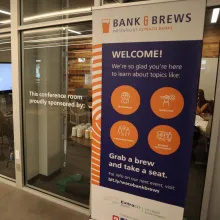Bank & Brews Waco | Utilizing Google Web Tools in Your Small Business Marketing Strategy

For our August Bank & Brews workshop, Extraco’s own Digital Marketing Specialist, Carina Yebra, walked attendees through what she considers to be essential, and often underutilized, tools for all businesses– Google Analytics, Google Tag Manager, Google Search Console, and Google My Business. In June, Carina took attendees on a deep dive into Google Analytics in Part 1 of this series (included in this blog). For Part 2, Carina recapped what businesses should know about Google Analytics, but elaborated more on Google's other tools and how to implement them into a business' marketing strategy.
Why is Marketing Data Important?
Throughout her career, Carina has seen business owners make the same mistakes when it comes to marketing their businesses. “A busy business owner might that they ‘know' their customers based on their day-to-day interactions with them, but they often don’t have data to back those assumptions up,” she shared. Businesses she works with typically think that utilizing data is expensive, complicated, and time consuming, but that is far from the truth. Not only are the tools that Carina recommends completely free, but the insight organizations can gain will often positively impact to their bottom line.
Here are the top five reasons why Carina says marketing data is important:
- Better understand consumer behavior - Learn who your actual customers (or potential customers) are, what they are doing, and how they interact with your business. Use this insight to predict trends, troubleshoot existing issues, and plan for the future of your company.
- Improve product and sales strategy - Use the data you have about your customers and their behavior to tailor your product and sales strategy. For example, if from the data you learn that your primary consumer is a digitally savvy Millennial, you may consider creating a 100% online sales process.
- Find proven marketing channels - Determine which marketing channels give your business the greatest traffic. Track marketing efforts using custom URLs and other conversion data.
- Cut unnecessary marketing spend - Focus on the paid marketing channels that have the highest return instead of ones that haven’t positively affected your revenues.
- Create more targeted and effective campaigns - Create target audiences based on your most profitable customers and market to them using your most proven marketing channels. Marketing campaigns and efforts should not be a shot in the dark. Use the actual data you have to create the most effective campaigns possible.
What is Google Analytics?
Most workshop attendees had heard of Google Analytics, but were not quite sure what it actually is. Google Analytics is a free website tool that allows you to capture data on all interactions that people have with your website. It provides data points like the number of page views, users, and sessions on your site, as well as anonymized demographic data of website visitors.
What can you learn from Google Analytics?
“In summary...a lot,” Carina told the audience. To make things easier to understand, she broke the data Google Analytics provides down into four main categories:
- Data about the users that visit your website (ex. How many users visit? Do they visit using a phone, computer, or tablet? What age group visits the site most often?)
- Information about the websites that bring traffic to your site (ex. How do people find the website? Which social media platform brings the most traffic? Which campaigns create the most visits and conversions?)
- Specifics on the performance of pages on your site (ex. Which pages are the most popular? How long do users spend on specific pages?)
- Insights on the actions users take on your site (ex. How many users call the business from the website? How many pages do they visit? How many people fill out web forms on the site?)
How to Start Using Google Analytics
Step 1: Create a Website
If your business already has a website, the hardest part is already over. If a company doesn’t have a website yet, there are dozens of easy-to-use website builders available. Even a basic site is essential for each and every business. “It doesn’t matter what industry you are in, every single one of your businesses should have a website,” Carina told the group of entrepreneurs. Not only do you need a site to even be able to utilize Google Analytics, but a website is critical to building credibility by providing the information consumers are looking for and showcasing your products and services. All of your marketing efforts should refer back to the primary source of information about your company– your site.
Step 2: Create a Google Analytics Account
Getting started is usually the most daunting step for business owners. Setting up an Analytics account is quick and a one time process. To get started, you’ll need to fill in some business information along with your website domain (ex. yourbusiness.com). After filling out the required details, you will be given a piece of tracking code containing an Analytics ID (which will look something like UA-1234567).
Step 3: Add the Analytics Tracking Code to the Website
Once your initial account setup is completed, Google will provide you with a snippet of JavaScript code. “At first glance it looks terrifying, especially if you are new to this, but it’s actually very simple,” Carina shared. If you built your site using a template-builder, look in the settings for a place to put the snippet of code or sometimes even just the Analytics ID (i.e. UA-123456). All modern-day site builders will have a location for this to go.
If you worked with a web developer to build your site, you will just need to send the code to them to place on each page of the website.
Step 4: Confirm the Tracking Code is Working and then Sit Back and Wait
Once the code is placed on each page of the site and you are logged into the Analytics platform, test that it is working by clicking on the Realtime dashboard while you have the website open. Analytics doesn’t collect data from before the tracking code was placed on the site, so Carina recommends waiting a few days, if not weeks, to start actively looking at the data. When Extraco launched their new website in 2020, Carina and her team did not begin analyzing the data for around 2-3 weeks. “We wanted to be sure that we had enough representative data to make informed decisions off of,” said Carina.
While some Google Analytics data is straightforward, Carina said that anybody who wants to efficiently utilize the tool should start with Google’s free Analytics certification courses.
How to use Google Analytics Data
Tracking Ad Performance
Once you’ve got a basic understanding of what Analytics can show you, you’ll be able to answer questions like “What are users most interested in on my site?” by looking at metrics like highest page views, lowest bounce rate, and time spent on-page. Carina and her team utilize the Campaigns tab often. “We assess how traffic to our site changes month-to-month based on different campaigns or marketing initiatives we’ve launched.” UTM tracking codes are a great tool to measure the traffic from a specific source. Carina recommended using a URL builder to add tracking to links. “When Extraco places a digital or print ad, the link we include always has tracking attached. That is how we can determine how many people found us from that specific piece of marketing.” Some businesses that she consulted in the past "spent thousands of dollars on marketing that they didn't even know worked or not.” Tracking how certain ad placements or initiatives are performing can help businesses avoid ineffective (and costly) marketing.
Setting Goals
Set goals within Google Analytics to measure things like products sold, phone calls placed, inquiry forms filled, and downloads of resources. Tracking these metrics regularly should help you to be able to create realistic and achievable goals.
What is Google Tag Manager?
Tag Manager is a slightly more advanced tool that you can use to implement code or tracking to your website. While this sounds difficult, Tag Manager actually reduces the need for website developers to maintain a business website and also improves site tracking accuracy with just a few simple steps.
What can you do with Google Tag Manager?
Google Tag Manager is another free tool that allows the user to easily implement tracking and more actions on the back-end of a website.
- Track events and activity in tandem with Google Analytics. Set up tracking for specific actions on your website (referred to as "events"). Track behaviors like PDF downloads, web forms submitted, and videos watched. For non-e-commerce sites, these actions are critical to business strategy.
- Reduce the need for a web developer to complete tasks like adding social media pixels, heatmaps, and more. Easily sync Google Conversion Tracking, Facebook or Linkedin Pixels, heatmaps, and more without needing coding knowledge.
How to Start Using Google Tag Manager
Take the Free Google Tag Manager Training Course
Carina highly recommends taking the Google Analytics Academy courses before getting started with Tag Manager. These courses are free and will help to demystify both Google Analytics and Tag Manager before you get started.
Create an Account or Login to an Existing Google Account
Visit tagmanager.google.com and follow the setup prompts. For this and all Google web tools, it is recommended that you create a new Gmail account for your business. You can use the same account for all Google web tools.
Create a Container for Your Website
Add the Google Tag Manager code provided during setup to your website. If you have a web developer, you will send them the snippet. If you have built your own site using sites like Wix, Squarespace, and WordPress, you'll add the code to the site Plugin Settings.
Add Google Analytics to Tag Manager
Your first tag should be for Google Analytics. When inside of Tag Manager, create a new tag. Select Google Analytics from the suggested options and enter your Universal Analytics variable ID (ex. UA-12345678). Now create a trigger. Add New Trigger - Page View - and All Page Views. Save your new tag.
New tags and triggers must be published. Once you've confirmed the details are correct, publish the newly added tags. Google Analytics tracking will go live immediately.
Create Additional Tags and Triggers Around Business Goals
Create a Tag Manager strategy around your business website goals. Set up event tracking for contact form submissions if that is the primary way for you to obtain leads. Need ideas? We like this list from Analytics Mania.
What is Google Search Console?
Search Console is a free dashboard that shows you how your website is performing technically. It offers helpful insight into how you rank on Google, why you rank that way, and provides analytics to optimize your website content.
What can you do with Google Search Console?
Search Console is full of helpful information. Find technical advice for how to best optimize your site, look at reports to show how your site is performing, and find opportunities for content based on what actual Google users are searching for and how they find your site.
- Check the health of your website by looking for broken links, monitoring site speed, and more.
- See how Google views your site by using the coverage reports to identify errors or issues that are affecting how Google indexes the pages.
- Keep track of how your website is performing by using performance metrics like clicks, impressions, click-through rate, and even the average ranking of your site in search.
What is Google My Business?
Google My Business is a free and essential business profile tool that helps organizations manage their online presence across Google. The information input here will adjust how your business appears in Google Search and Google Maps.
What can you do with Google My Business?
You can do all kinds of things using GMB. From posting the most current and accurate information for your business such as hours, address, contact information and more to collecting and responding to customer reviews, Google My Business is an awesome tool.
- Provide the most accurate operations details for your business(es) and their locations.
- See insights on how many people search, call, and navigate to your business using Google Search and Maps.
- Manage your online reputation by soliciting and responding to customer reviews.
- Accept and respond to messages from customers and potential customers.
- Post photos of your storefront, services, and products to entice potential customers.
- Accept online bookings and appointments for meetings and services.
- Create a landing page or mini-website to act as a source of information for potential customers.
- Create advertisements and posts to let the community know what you are offering.
Utilizing Google website tools for your business is a free and simple way to incorporate marketing data into your everyday operations. You should use this data to inform your marketing and business decisions, troubleshoot potential issues, and provide an excellent customer experience.



Information about Bank & Brews
In partnership with Startup Waco, Bank & Brews is designed for anybody who wants to learn more about starting or growing a business! These monthly events are free and are now hosted in-person and virtually. Visit Extraco's Facebook page to learn more about upcoming Bank & Brews!
About Extraco Banks
Extraco Banks and its affiliate companies are dedicated to building people, businesses and communities. Since the Great Recession, Extraco has extended over $2.5 billion in loans to 25,000 customers, while financially supporting over 1,275 community organizations working to create economic vibrancy, job growth and overall quality of life to our communities across central Texas. Founded as a cotton warehousing company, Extraco, at $1.5 billion in assets, is the largest and most comprehensive locally owned bank between Dallas and Austin, serving over 120,000 customers' banking, mortgage, insurance, and wealth & trust needs with creative and innovative excellence.
Learn more at: https://www.extracobanks.com/.




